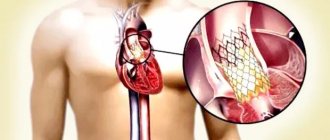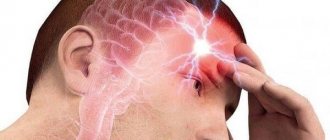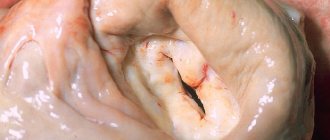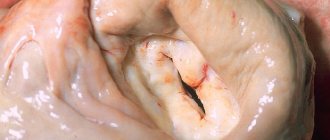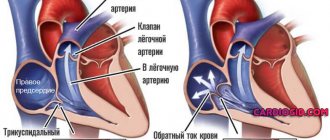In most cases, people perceive diseases associated with the cardiovascular system as something very serious and life-threatening. And it’s true, if someone says that they have “heart problems,” it sounds worse than “problems with the gastrointestinal tract or nervous system.” However, in practice, some cardiac pathologies may be considered non-critical. Certain heart conditions may also qualify for military service. In this regard, we invite you to understand the issues of conscription into the army during regurgitation . Is this a conscription pathology, or can a conscript count on receiving an exemption?
Find out if there are grounds for exemption from the army
Take the test and find out if you have grounds to legally receive a military ID due to health reasons.
Take the test ~ 1 minute
Aortic regurgitation (aortic valve insufficiency)
Aortic regurgitation
is the backflow of blood through the aortic valve into the left ventricle when the left ventricle relaxes during each cardiac cycle. The aortic valve opens when the left ventricle contracts and pushes blood into the aorta. If the aortic valve leaflets do not close completely, backflow of blood from the aorta into the left ventricle occurs.
To compensate for the load on the heart, the muscular walls of the ventricles thicken (hypertrophy) and the chambers of the ventricles increase in size (dilate). Eventually, despite this compensation, the heart loses its ability to meet the body's blood needs, leading to heart failure with fluid accumulation in the lungs.
Aortic valve regurgitation can develop suddenly (acute) or gradually (chronic).
Causes
Acute aortic regurgitation
- Valve infection (infective endocarditis)
- Rupture of the aortic lining (aortic dissection)
Chronic aortic regurgitation
- Spontaneous weakening of the valve or ascending aorta (congenital defect)
- Rheumatic fever
Symptoms
- Heart murmurs
- Dyspnea
- Chest pain
- Heartbeat
Mild aortic regurgitation causes no symptoms other than a characteristic heart murmur that can be heard with a stethoscope whenever the left ventricle relaxes. Symptoms in people with severe regurgitation may occur as heart failure develops.
Heart failure causes shortness of breath on exertion. The patient's breathing is difficult when lying down, especially at night. Changing to a sitting position allows accumulated fluid to drain from the top of the lungs, which helps restore normal breathing. Some patients with aortic regurgitation experience chest pain due to insufficient blood supply to the heart muscle (angina), especially at night.
The pulse, sometimes called a racing pulse, becomes momentarily strong and then quickly disappears as blood leaks back through the aortic valve into the heart, causing blood pressure to drop sharply.
Diagnostics
The diagnosis is based on the results of a medical examination (namely, a jumping pulse and characteristic heart murmurs) and is confirmed through examination. For this purpose, the doctor may prescribe:
- echocardiography;
- computed tomography (CT);
- magnetic resonance imaging (MRI);
- X-ray examination of the chest organs;
- electrocardiography (ECG);
- coronary angiography (before surgical treatment).
Treatment
Drug treatment is not particularly effective in slowing the progression of heart failure. Treatment depends on the cause and symptoms of the disease, the severity of the disease, as well as the presence of comorbidities and drug therapy received for the comorbidity. Taking this into account, the doctor may prescribe:
- medications;
- heart valve replacement.
Source
Regurgitation on the tricuspid valve
Tricuspid regurgitation
- This is the leakage of blood in the opposite direction through the tricuspid valve each time the right ventricle contracts. The tricuspid valve is located in the opening between the right atrium and the right ventricle.
The tricuspid valve opens, allowing blood from the right atrium to enter the right ventricle, and closes when the right ventricle contracts, pushing blood into the lungs. If the tricuspid valve does not close completely, some blood leaks back into the right atrium - called regurgitation.
Tricuspid valve insufficiency can be primary or secondary (the most common).
Causes
Symptoms
Diagnostics
Diagnosis is based on history, physical examination, and examination results. To clarify the diagnosis, the doctor may prescribe the following types of examination:
- electrocardiography (ECG);
- X-ray examination of the chest organs;
- echocardiography;
- magnetic resonance imaging (MRI) of the heart;
- cardiac catheterization.
Is he fit to have this diagnosis?
Suitable for the diagnosis: Fragmentary, marginal sealing of the aortic valve leaflets. Aortic - valvular regurgitation of the 1st degree. Mitral - valvular regurgitation of the 1st degree. Tricuspid - valvular regurgitation of the 1st degree. Pulmonary valve regurgitation grade 1. False chord of the left ventricle Bradycardia.
ANSWERS TO QUESTION (1)
The presence of aortic valve regurgitation makes you unfit for at least point “c” of Article 80 of the Schedule of Diseases:
isolated congenital heart defects in the absence of chronic heart failure;
Aortic regurgitation of any degree is aortic valve insufficiency as explained below (page 92):
A violation of intracardiac hemodynamics should be considered constant regurgitation of grade I or more. Prevalvular (minimal) regurgitation refers to grade I regurgitation. If grade I regurgitation is detected on the aortic valve, it should be regarded (regardless of other indicators) as aortic valve insufficiency.
And aortic valve insufficiency is an isolated congenital heart defect, as is clear from point “a”:
isolated congenital heart defects (aortic stenosis, pulmonary artery stenosis, left atrioventricular orifice stenosis, aortic valve insufficiency, (mitral) valve, prolapsed aortic valve leaflets, bicuspid aortic valve , myxomatosis, aneurysm of the interatrial septum, interventricular septum or sinus of Valsalva, fenestration of the valve leaflets with blood regurgitation, patent ductus arteriosus, ventricular or atrial septal defect, etc.)
Source
Congenital heart disease and the army: what determines the decision of the military registration and enlistment office?
Congenital and acquired heart defects are not a specific diagnosis, but a group of cardiovascular diseases. These include ventricular septal defects, atrial septal defects, septal defects between the aorta and pulmonary artery, Tetralogy of Fallot, etc.
Such pathologies can occur in different ways, so it is impossible to say for sure whether the patient will be called up for military service. The fitness category and the likelihood of conscription will depend on four conditions:
- presence of heart failure,
- degree of regurgitation (outflow of blood),
- work of heart valves,
- state of health at the time of medical examination.
Depending on the combination of these factors, a young man may be released from the army, drafted, or removed from military registration altogether.
Get relief from regurgitation
Our legal experts help conscripts obtain a military ID for health reasons legally. We provide a free consultation, during which you can talk about your situation and ask questions to experts regarding regurgitation in a conscript . To get advice, you should contact the phone numbers listed on our website, and specialists will promptly help you.
In addition to consultations, our lawyers can accompany the conscript to the military medical commission and properly prepare him for the commission. We also help to collect all the documentation that may be required during recruitment events at the military commissariat. If you have been assigned a fitness category that you do not agree with, you can contact our company and we will help you appeal the decision to a higher military commissariat or in court.
Law company Povestok.Net®
We have been protecting the rights and interests of conscripts since 2015.
Services for conscripts ›
Exemption from the army for congenital heart defects
You can receive an exemption from the army under the UPS only in two cases: if the draft commission approves the fitness category “B” or “D”.
Non-conscription fitness category “B” can be obtained for congenital valve defects and atrial septal defects. In such conditions, young people are enlisted in the reserve. However, if the state announces a general mobilization, they may be called into service.
In the most difficult cases, the draft commission must assign the young man category “D”. This is the lowest indicator of suitability: it is given for serious health problems. Holders of “D” do not serve in the army, are not called to military training and are not registered with the military registration and enlistment office.
You can get a “D” in two cases:
- for isolated aortic PS and heart failure FC II–IV (FC is a functional class. It is determined by a cardiologist using a number of medical studies);
- in the presence of congenital PS with heart failure class II, regurgitation of the second degree and insufficiency of the aortic, mitral and tricuspid valves.
Problems a recruit may encounter
It happens that even with a non-conscription diagnosis, a young man is given a draft eligibility category. This can happen for various reasons, but let's look at the most common one.
After passing the military medical commission, specialists write a referral for an additional examination to the conscript, he will need to undergo it. As soon as he receives all the results of tests and studies, the doctor responsible for conducting the additional examination is obliged to confirm the presence of a diagnosis, or indicate its absence. At this stage, the most common problem may arise - the specialist indicates an incorrect formulation of the diagnosis.
In this case, even if the conscript has a non-conscription illness, he may be sent to serve. It is necessary to carefully check the wording indicated by the specialist in the extract. To obtain an exemption, it is very important that this wording is exactly the same as provided in the Schedule of Illness document. If you make a mistake, you may not hope to receive a military ID due to health reasons. The maximum that you can be given is a deferment from the army in case of regurgitation.
In what cases with heart defects are they recruited into the army?
There are exceptions to every rule, and so it is with UPS. A diagnosis that at first glance looks serious may not prevent recruitment. For example, they can serve a combat summons for a bicuspid aortic valve if it is working correctly, the disease is compensated and there are no signs of regurgitation - reverse blood flow. People with this disease will not be accepted into the airborne or infantry forces, but in military units with minimal physical activity the soldier will feel comfortable.
Sometimes young people and their parents consider a disease such as PFO, a patent foramen ovale, to be a defect. Although there is still debate among cardiologists, this diagnosis is usually referred to not as congenital heart disease, but as minor anomalies of the heart (MARS).
This anomaly is also interesting because it is not always confirmed by additional examination. The young man, confident in his diagnosis since childhood, undergoes an examination from the military registration and enlistment office and, after diagnosis, finds out that he is fit. The reason is that doctors may make a misdiagnosis during a blood drain. However, even if the pathology is confirmed, the patient can still be taken away. It is believed that if a conscript does not have a blood discharge, then he is capable of serving.
We have launched a free service “Conscript Health Card”. Take a little testing and find out what non-vaccine diseases you may have.
Still have questions after the article? Call us at 8 (800) 333-53-63, and we will definitely answer them.
Sincerely, Zhanna Markova, lawyer of the Assistance Service for Conscripts.
Source
How regurgitation can affect the call
Most conscripts diagnosed with mitral regurgitation wonder whether their disease is compatible with military service and how it may affect conscription. The same question arises for conscripts with aortic regurgitation or tricuspid valve regurgitation. Regardless of which of these three options a conscript has, the pathology should not be displayed on the draft. Thus, a young man with diagnosed regurgitation is not limited in his fitness for military service. A conscript with this diagnosis may be sent to serve in the Russian army.
However, in practice everything is not so clear. Not all conscripts who have a similar pathology will necessarily be sent to serve. The problem is that in the main document of the Schedule of Diseases, which guides the specialists of the military medical commission when establishing a fitness category, there is no information about the description of this pathology. Thus, it is difficult to say how it can influence the eligibility category of a conscript.
It is worth noting in advance that regurgitation cannot be considered the main diagnosis. As a rule, this is a syndrome that accompanies any disease. Regurgitation is reverse blood flow, which occurs if the patient has diseases of the cardiovascular system. Note that this disease may fall into the category of non-vocational pathologies according to the Schedule of Diseases.
— Alina Petrova, director of Povestok.Net

